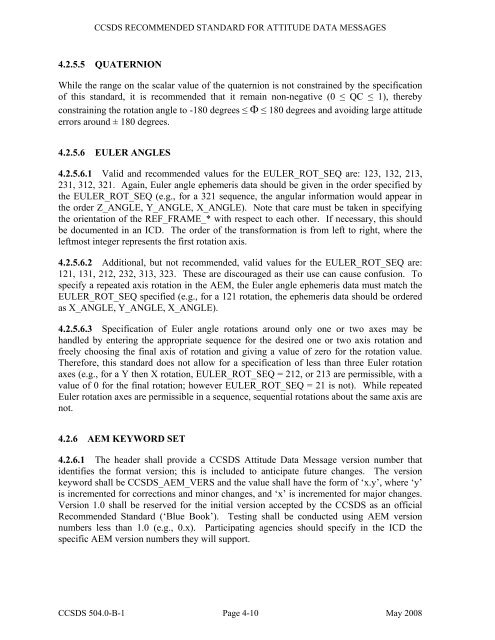Attitude Data Messages - CCSDS
Attitude Data Messages - CCSDS
Attitude Data Messages - CCSDS
You also want an ePaper? Increase the reach of your titles
YUMPU automatically turns print PDFs into web optimized ePapers that Google loves.
<strong>CCSDS</strong> RECOMMENDED STANDARD FOR ATTITUDE DATA MESSAGES<br />
4.2.5.5 QUATERNION<br />
While the range on the scalar value of the quaternion is not constrained by the specification<br />
of this standard, it is recommended that it remain non-negative (0 ≤ QC ≤ 1), thereby<br />
constraining the rotation angle to -180 degrees ≤ Φ ≤ 180 degrees and avoiding large attitude<br />
errors around ± 180 degrees.<br />
4.2.5.6 EULER ANGLES<br />
4.2.5.6.1 Valid and recommended values for the EULER_ROT_SEQ are: 123, 132, 213,<br />
231, 312, 321. Again, Euler angle ephemeris data should be given in the order specified by<br />
the EULER_ROT_SEQ (e.g., for a 321 sequence, the angular information would appear in<br />
the order Z_ANGLE, Y_ANGLE, X_ANGLE). Note that care must be taken in specifying<br />
the orientation of the REF_FRAME_* with respect to each other. If necessary, this should<br />
be documented in an ICD. The order of the transformation is from left to right, where the<br />
leftmost integer represents the first rotation axis.<br />
4.2.5.6.2 Additional, but not recommended, valid values for the EULER_ROT_SEQ are:<br />
121, 131, 212, 232, 313, 323. These are discouraged as their use can cause confusion. To<br />
specify a repeated axis rotation in the AEM, the Euler angle ephemeris data must match the<br />
EULER_ROT_SEQ specified (e.g., for a 121 rotation, the ephemeris data should be ordered<br />
as X_ANGLE, Y_ANGLE, X_ANGLE).<br />
4.2.5.6.3 Specification of Euler angle rotations around only one or two axes may be<br />
handled by entering the appropriate sequence for the desired one or two axis rotation and<br />
freely choosing the final axis of rotation and giving a value of zero for the rotation value.<br />
Therefore, this standard does not allow for a specification of less than three Euler rotation<br />
axes (e.g., for a Y then X rotation, EULER_ROT_SEQ = 212, or 213 are permissible, with a<br />
value of 0 for the final rotation; however EULER_ROT_SEQ = 21 is not). While repeated<br />
Euler rotation axes are permissible in a sequence, sequential rotations about the same axis are<br />
not.<br />
4.2.6 AEM KEYWORD SET<br />
4.2.6.1 The header shall provide a <strong>CCSDS</strong> <strong>Attitude</strong> <strong>Data</strong> Message version number that<br />
identifies the format version; this is included to anticipate future changes. The version<br />
keyword shall be <strong>CCSDS</strong>_AEM_VERS and the value shall have the form of ‘x.y’, where ‘y’<br />
is incremented for corrections and minor changes, and ‘x’ is incremented for major changes.<br />
Version 1.0 shall be reserved for the initial version accepted by the <strong>CCSDS</strong> as an official<br />
Recommended Standard (‘Blue Book’). Testing shall be conducted using AEM version<br />
numbers less than 1.0 (e.g., 0.x). Participating agencies should specify in the ICD the<br />
specific AEM version numbers they will support.<br />
<strong>CCSDS</strong> 504.0-B-1 Page 4-10 May 2008

















